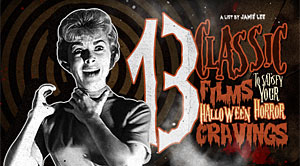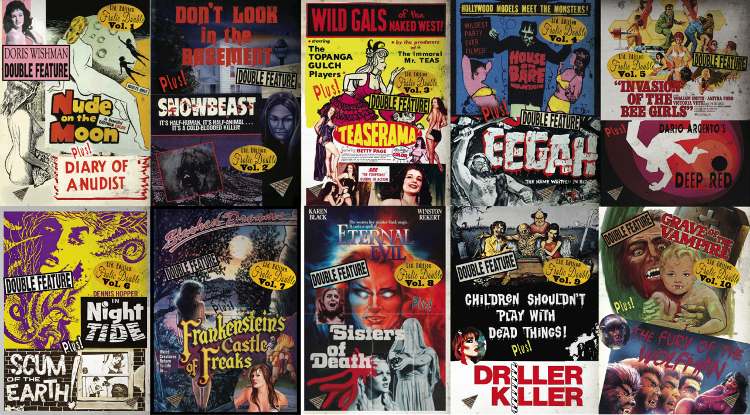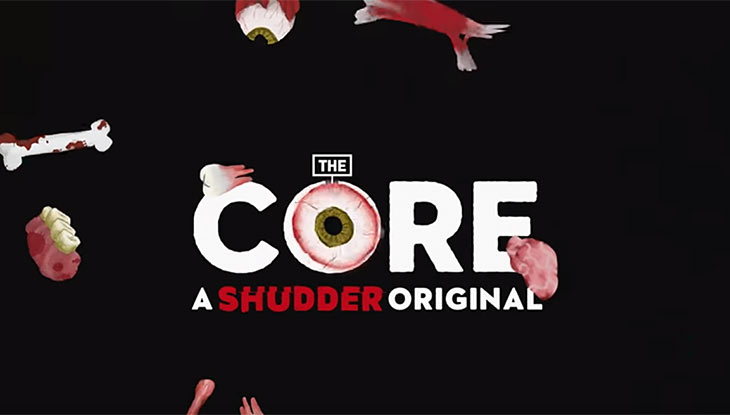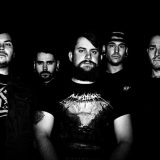No.7 Cat People (1942)
Produced by horror superproducer Val Lewton, Cat People is one of the most sexually charged early horror films in history. The whole premise of the film revolves around a beautiful and mysterious young woman, Irena (Simone Simon) who believes that she’s descended from a race of some kind of crazy shapeshifters that turn into panthers when they’re sexually aroused. Sure, the myth in the movie is told a hell of a lot more eloquently and enchantingly, but that’s the jist of it.Irena shares her belief with a marine engineer, Oliver (Kent Smith), who is quickly smitten with Irena. Even though Irena’s a little cuckoo for Cocoa Puffs, Oliver manages to persuade the Serbian-born woman to marry him. The marriage is challenged by Irena’s reluctance to sleep with her husband. Irena is persuaded further by Oliver to see a psychiatrist, who, of course, is drawn to Irena.
Things end tragically for most of the cast, but the journey to the end is a suspenseful ride that relies on the things you don’t see more than what’s actually presented to carry it — and carry it far it does.
Cat People also spawned a more familiar, notable remake in 1982 starring Malcolm McDowell and Nastassja Kinski, and, in turn, a bitchin’ theme song by David Bowie. If you haven’t seen either movie, it’s definitely worth your while — and it’s interesting to see sexuality on film in 1942, and the evolution it’s made in modern horror.
No.6 Nosferatu (1922)
German expressionism never looked better. This famous, unauthorized adaptation of Bram Stoker’s Dracula changed few of the plot points, save for a few names and places.Everyone here knows the story of Dracula, right? Just for shits and giggles, let me go ahead and give you a quick synopsis: Thomas Hutter lives in Wisborg, Germany. His boss, Knock, sends him to Transylvania to meet with a new client named Count Orlok. Soon, Hutter learns that not all is well in Transylvania.
Nosferatu was one of the first horror films to remind us that while terrifying and traditionally thought of as ugly, horror can also be beautiful. Don’t get me wrong, this film is primitive in almost every way imaginable, but the simplistic gives way to something more here that’s a refreshing change of pace from the overproduced, trying-too-hard modern horror that most viewers have become accustomed to.
Max Schreck’s performance as Count Orlok is something that will stick with most cinema fans for years to come for some reason or another. The guy is a strange lookin’ dude for one, and secondly, there’s a kind of beautiful sadness to his movements. This is a silent movie, so every bit of acting is conveyed through body language and facial expressions. To see a man act as vividly as Schreck does in this movie almost brings a tear. But that’s all just pussy talk, right? Back to the sickness!
No.5 Freaks (1932)
Tod Browning directed and produced this film, and somehow even got MGM to release it. No easy feat in 1932, considering that this movie was about and starring the undesirables of the world: sideshow freaks. More importantly, if you have ever heard the phrase “Gooble gobble, one of us!” and wondered where it came from, now you know.Freaks is the story of physically deformed carnival people (played, yes, by real carnival people — remember, back in 1932, there wasn’t much in the way of special effects) who are trusting, kind, and honorable. That in and of itself is an odd portrayal of the sideshow circuit, but director Tod Browning traveled with the circus when he was young and drew most of his inspiration from his own personal experiences with it.
A self-serving trapeze artist named Cleopatra (Olga Baclanova) seduces and marries a sideshow midget, Hans (Harry Earles), but only after sweet little Cleo learns that Hans is a very wealthy man. It’s obvious that the love Hans feels for Cleo is true, especially after she humiliates him in front of his friends, whom she mocks relentlessly and brutally. Cleopatra is so dead set on getting at Hans’ large inheritance that she poisons his wine. This does not sit well with the freaks, making for one of the first horror-film revenge plots brought to the silver screen.
Freaks was a ballsy film for it’s time; no one wanted to see carnival people as good. In this movie, it’s the normies who are painted in an unflattering and harsh light. The movie ended up seeing roughly 30 minutes worth of cuts as it was; it was trimmed from 90 to 64 minutes before it could see the light of day. One woman threatened to sue MGM, claiming the film had caused her to miscarry after a test screening. It’s safe to say that the film retained a high level of controversery for some time after it’s release. It brought Tod Browning’s cinematic career to an end and was banned in the UK for over 30 years. Today, the film remains a horror classic that pushed boundaries that society was uncomfortable with — which says something about our society.
No.4 Carnival of Souls (1962)
Alright, so I’ve kinda got this wicked boner for classic independent horror movies. This movie was only produced for around $33,000 back in 1962 and god knows how much it made back; probably not enough. It didn’t gain any widespread attention when it was released, but it has gained attention in later years as a cult classic. It is without a doubt one of the most unnerving and creepy movies that I’ve ever seen, and it’s especially unnerving to watch in black and white because it adds so much to the ambiance.The movie follows the story of a young organist named Mary Henry (Candace Hilligoss), who is the sole survivor of a car accident. Mary is not what you would call a social butterfly, or even personable; she’s a stone-cold bitch. It’s implied that she became this way after the accident or because of it, but there’s something distinctly chilling about Mary’s nature.
Mary is simultaneously drawn to an abandoned amusement park and haunted by visions of a ghoulish presence (called The Man in the credits, played by director Herk Harvey). She soon finds that she at times becomes invisible and inaudible to the world around her, trapped in between the realm of the living and the dead. The eerie organ music that scores this film, paired with the dreamy, ethereal feel to it works wonders in making the viewer feel uneasy. The shots of Mary trying to get people’s attention and being ignored are so well done that it conveys a solid sense of isolation to the audience and has made me shiver a time or two. This is an example of early psychological horror at it’s finest, and can leave one wondering: What really happens when you die? Is there ever truly peace?
No.3 The Innocents (1961)
The Innocents is another fine example of early mind fucks in cinema. Based on the novel The Turn of The Screw, The Innocents is the story of Miss Giddens (Deborah Kerr), a young and inexperienced governess hired by a wealthy bachelor to take care of his orphaned niece and nephew, whom he has no room mentally or emotionally for. All he really wants is for Miss Giddens to take full responsibility for his niece and nephew while he pursues traveling and socializing. All is well and good, until you learn that the previous governess, Miss Jessel, died mysteriously a year ago.Personally, I would have told him that I wasn’t going to be the next dead babysitter at his country home, no matter how delightful and charming and English it was.
Miss Giddens is instantly smitten with Flora, who insists that her brother Miles is coming home from boarding school. Soon enough he does just that. The children are both polite and well-mannered enough, but Miss Giddens soon becomes unnerved by their strange bouts of distinctly unchildlike behavior. Even more worrisome are the unexplainable voices she hears and the visions of a man and woman whom the housekeeper, Mrs. Grose, says are Miss Jessel and Peter Quint — the valet of the manor, until he died. Mrs. Grose then reveals that Quint and Miss Jessel were lovers in an abusive relationship and were quite indiscreet, hinting that the children may have gotten an unneeded lesson in the birds and the bees.
This is truly a movie that has to be seen to be completely enjoyed, so I won’t ruin the rest of the plot for you, but the isolation of the English manor coupled with the ambient noises in the film provide an eerie, otherworldly effect that when teemed with the performances from the two creepy tots leaves a powerful impact on the viewer.
No.2 The Haunting (1963)
Another psychological horror movie? Say it ain’t so. I’m sorry, but it is; you’re talking to Little Miss Mindfuck here.Chances are you might have seen the remake featuring Catherine Zeta-Jones as a liberated slut. Sure, Liam Neeson, Lily Taylor, and Owen Wilson were in there somewhere too, but I know what my main selling point was in the remake. The original film is markedly less sexy than it’s remake (boo, I know), but it still packs a punch. Paranormal investigator Dr. Markway (Richard Johnson) invites skeptical Luke Sanderson (Russ Tamblyn), clairvoyant Theo (Claire Bloom), and sensitive Nell (Julie Harris) to Hill House, a sinister manor with a checkered past. Much to Dr. Markway’s delight, strange things do begin to happen; but the house seems to have it in for poor, sweet Nell.
Once again, this is a film that relies upon suspense and the unseen rather than anything that you could see. I know, these days it’s a novel concept to think that there was a time when horror movies could stand on their own two feet without showing something like a fetus eating it’s way out of a vagina, but there was. And it was great. This film is another prime example of the power of suggestion. This is a movie that depends on it’s actors to properly convey the tone of the film, and they do it with aplomb. The spiraling and wide camera angles add to the film and you get a true sense of terror while watching this movie.
If you need further persuasion to pursue this movie, Marty Scorsese himself placed The Haunting first on his list of the 11 best horror films of all time.
No.1 Night of the Living Dead (1968)
I feel like before we even start talking about this film, I have to say how utterly obsessed I am with it. At one point I owned five copies of it (hey, some were gifts, OK?) and had a poster of it hanging in the most sacred spot: above one’s bed. It’s the movie that most famously brought zombies to the attention of our sleepy little country, is the origin of six other Living Dead movies, and has had two remakes made of it.Night of the Living Dead was an indie flick made in 1968 by a man named George A. Romero. The movie has long been picked apart by critics and fans over whether it’s a political film or just a horror movie that started a whole new genre and broke taboos all across the board.
Night of the Living Dead is THE seminal zombie movie and it deserves to be recognized more than it has been in recent years. Though it took it’s cues from Richard Matheson’s 1954 novel I Am Legend (which has spawned four films based on it, most memorably, the one with Will Smith — yeah, that one), Night of the Living Dead still remains one of the most original works in horror film history, creating a legacy that few film series even come close to replicating.
Most moviegoers at the time would have never dreamed of walking corpses with cannibalistic tendencies, and the first images that you see of a horde of slow moving zombies shambling toward you, some of them digging into human flesh, lasts for a long time to come.


















Stay Connected